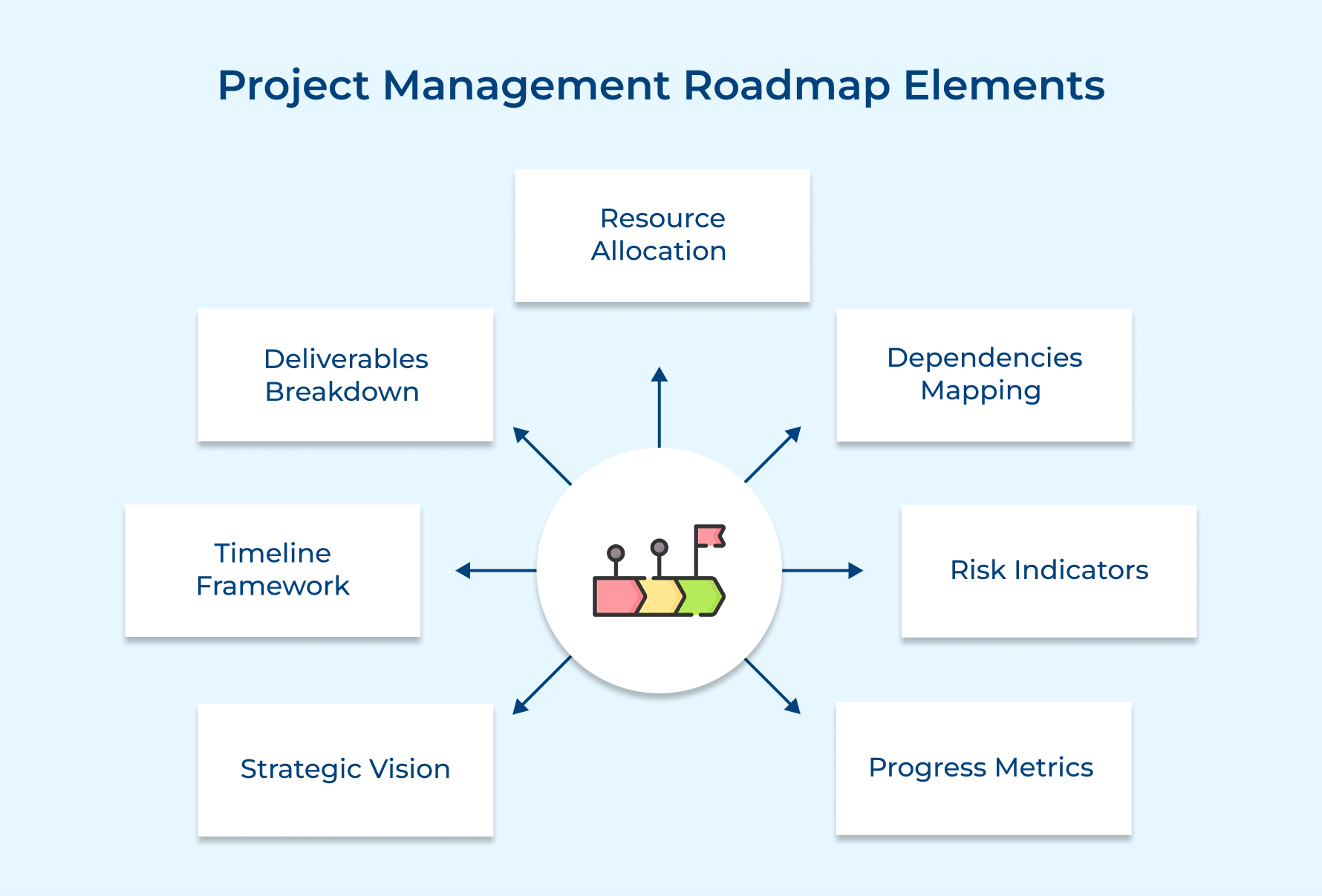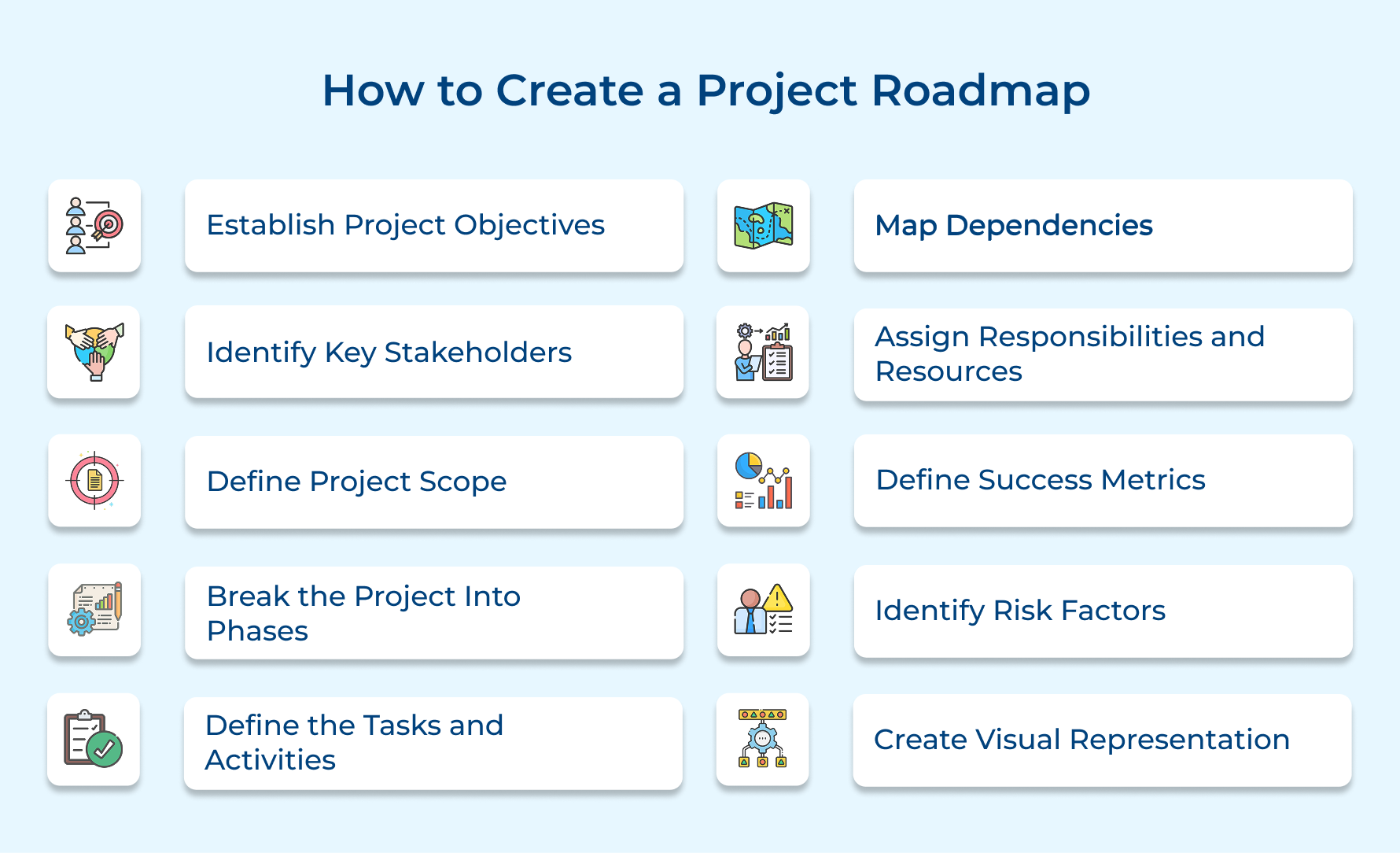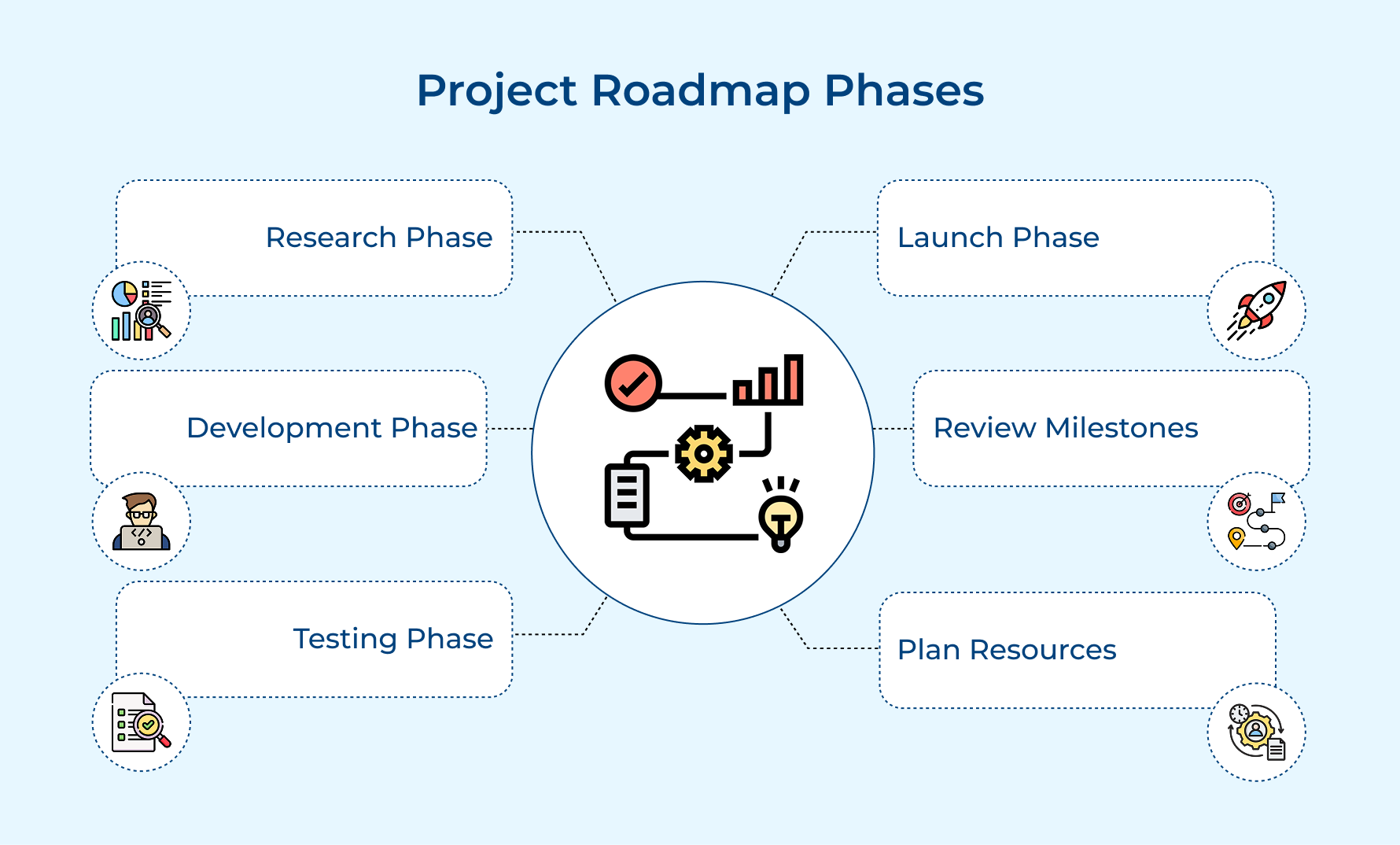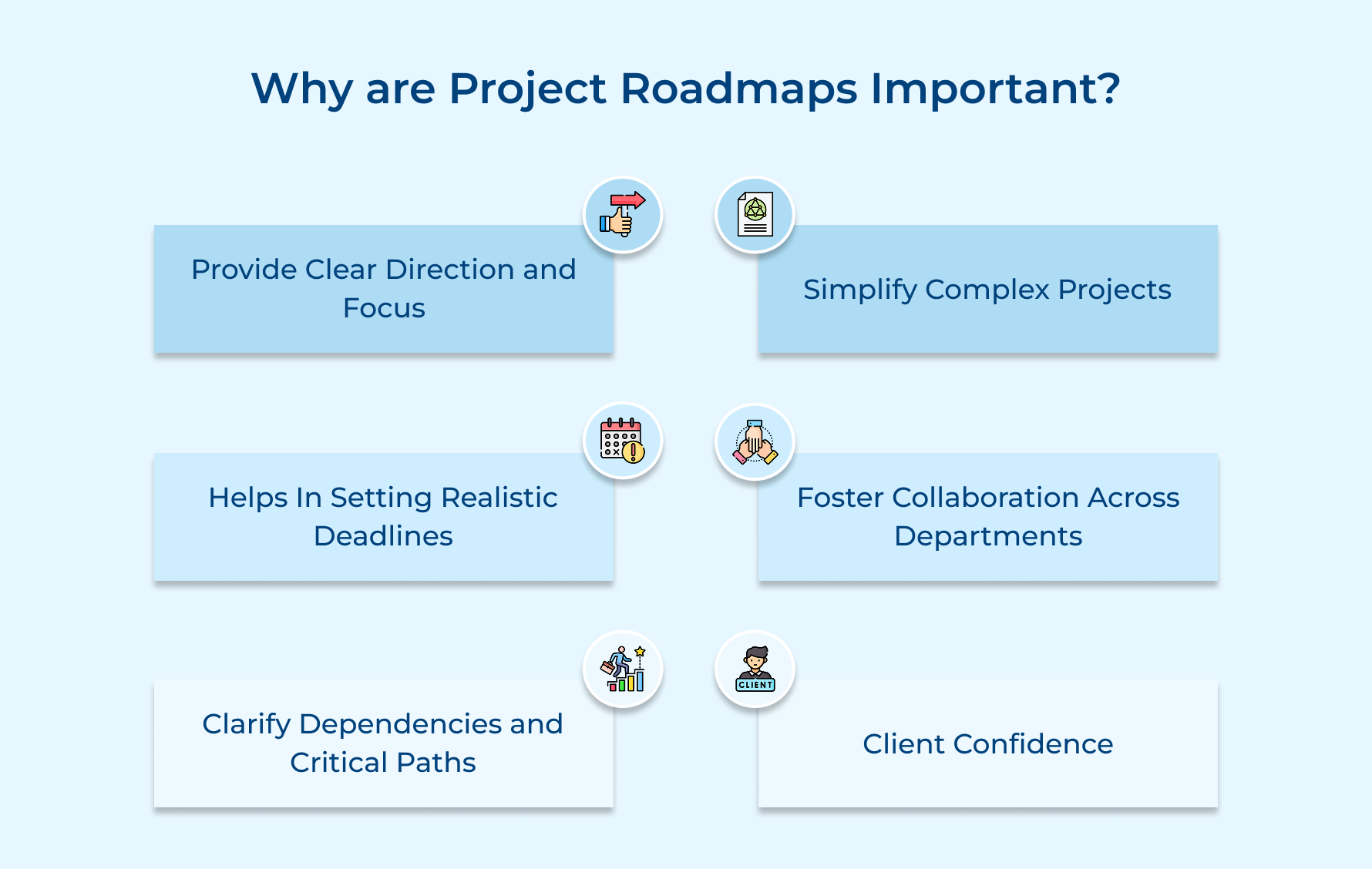How to Build a Project Roadmap: 10 Steps to Success

Key Highlights:
- Project roadmaps define desired outcomes, aligning teams with project goals and business value.
- Break projects into manageable phases that reduce overwhelm and ensure systematic progression.
- Enhance communication between different teams by clarifying task contributions.
Are you struggling with misaligned project teams, missed deadlines, and unclear client expectations? Professional service firms often face the challenge of managing complex projects while maintaining client confidence and team efficiency.
A well-crafted project roadmap transforms chaos into clarity, serving as your strategic compass for project success. Professional firms leverage roadmaps to align stakeholders, optimize resources, and maintain clear progress tracking throughout project execution.
Smart road mapping techniques empower agencies to deliver consistent value while upholding professional excellence. Let’s explore how a well-crafted roadmap can streamline your project management process.
What is a Project Roadmap?
A project roadmap definition explains about a strategic high-level overview document that outlines the vision, direction, and progress of a project over time. It serves as a visual communication tool that aligns project stakeholders, team members, and clients on project goals, major milestones, deliverables as well as timelines.
For agencies managing multiple client projects, roadmaps help maintain transparency, set realistic expectations, and facilitate resource allocation in real-time. They provide a strategic overview and a clear framework for communicating project status to clients, ensuring deliverables align with business objectives.
Key objectives:
- Strategic alignment: Ensures all project activities and deliverables directly support the client’s business high-level goals.
- Resource optimization: Facilitates effective allocation along with scheduling of team members, tools, and budget across project phases.
- Stakeholder communication: Provides a clear, visual reference point for updating clients and internal teams on project milestones.
- Risk management: Enables early identification of potential obstacles and dependencies, allowing for timely adjustments to keep the project on track.
Key Elements of a Roadmap in Project Management
A well-designed project roadmap aligns teams and ensures seamless execution. Let us learn how it helps you with project as well as resource management.
A project roadmap starts with a clear and strategic vision. It defines the desired outcomes and highlights the business value, ensuring your goals align with the broader organizational vision. It gives your team a sense of direction and focus for execution planning.
Next up is the timeline framework. A well-structured timeline lays out project phases, key milestones, and delivery dates in chronological order. It helps everyone understand the sequence of activities and the expected duration, ensuring a smooth workflow.
Breaking down deliverables is key. Each phase should have detailed outputs with specific deadlines. The clarity helps teams know what to deliver and ensure all the pieces fit into the bigger picture.
Resource allocation is another critical piece. Mapping out the resources—team members, skills, and tools—needed at various stages allows managers to plan while also avoiding bottlenecks.
Don’t forget dependency mapping! Identifying task relationships and their impact points ensures proper coordination and averts unnecessary delays.
Stay proactive with risk indicators and progress metrics. Highlight potential obstacles and set measurable success targets to track progress as well as maintain quality throughout the project.
These elements in place help your roadmap become a powerful guide to project success.
10 Effective Ways to Create a Project Roadmap
Creating a project roadmap requires a strategic approach to ensure clarity and efficiency. Here are 10 effective ways to design a roadmap that drives successful project execution.
1. Establish Project Objectives
Project objectives are the foundation of any successful project. They define what the project aims to achieve, outlining specific, measurable goals that guide execution and decision-making. Here’s why they’re essential and how to craft them effectively:
Why do Objectives Matter?
- Provide clear direction and purpose for the team.
- Keep the focus on desired outcomes and expected benefits.
- Help stakeholders understand what success looks like.
- Reduce risks of losing direction or failing to deliver value.
How Objectives Support Success?
- Decision-making: Teams can reference objectives to resolve conflicts and make informed decisions.
- Resource Allocation: Guide where to allocate resources effectively.
- Progress Tracking: Help measure progress and determine if deliverables align with goals.
Actionable Tips:
1. Use SMART Criteria:
- Specific: Clearly define what you want to achieve.
- Measurable: Quantify success with metrics.
- Achievable: Ensure goals are realistic.
- Relevant: Align with project and organizational priorities.
- Time-bound: Set deadlines for accountability.
2. Align with Organizational Goals: Validate objectives with stakeholders to ensure alignment.
3. Break Down Goals: Create a hierarchy of primary objectives and sub-objectives for better manageability.
2. Identify Key Stakeholders
Stakeholder identification is about mapping everyone involved in or impacted by your project. Let’s take a sample project roadmap, if you’re building a community park, stakeholders might include local residents, the city council, environmental groups, and nearby businesses. Each group has unique interests—residents may prioritize safety, while the council focuses on approvals.
Understanding stakeholders helps manage expectations, align project outcomes with their needs, and secure support. For instance, consulting environmental groups early can prevent opposition later.
To manage stakeholders effectively, create a stakeholder matrix categorizing them by influence and interest levels. Develop personalized communication strategies, like sending detailed plans to the council and simplified updates to residents.
3. Define Project Scope
Project scope sets clear boundaries for the work to be done, detailing deliverables, features, functions, and requirements.
Why Should You Define Scope?
- Prevents Feature Creep: Avoids unplanned additions that can derail the project.
- Manages Expectations: Ensures everyone understands what’s included and what isn’t.
- Optimizes Resources: Allocates time, budget, and effort where they’re needed most.
How Scope Helps Teams:
- Acts as a reference for validating requests and managing changes.
- Keeps focus on planned deliverables, preventing unnecessary work.
- Serves as a baseline for tracking progress and aligning with stakeholders.
Tips to Consider,
- Write a Detailed Scope Statement: Clearly define what’s included, excluded, and any assumptions.
- Implement Change Management: Create a formal process for handling scope modification requests systematically.
- Regular Reviews: Collaborate with stakeholders to revisit the scope periodically and maintain alignment.
4. Break the Project into Phases
Phase breakdown is all about dividing a project into smaller, manageable stages. Each phase has its own deliverables, making complex work more organized and easier to handle.
Breaking the project into phases allows teams to focus on one step at a time while keeping the big picture in mind.
For example, if you’re launching a new product, you might start with research, move to development, then testing and rollout. This approach ensures better resource planning and gives natural checkpoints to review progress.
Teams can organize work, schedule resources, and set milestones for each phase. Completing one phase before starting the next ensures systematic progression and avoids chaos.
5. Define Tasks and Activities
Task definition involves breaking down each project phase into specific activities and work packages. It includes identifying individual tasks needed to complete project deliverables.
Detailed task definition enables accurate resource allocation, timeline estimation, and progress tracking. Project management tools help team members understand their responsibilities and ensure all necessary work is identified and planned.
Create detailed work schedules, assign resources, and track progress at a granular level. Teams use task definitions to coordinate work efforts and ensure all components of deliverables are addressed.
Actionable Tips:
- Use a Work Breakdown Structure (WBS) to systematically decompose project work into manageable tasks
- Include effort estimates and skill requirements for each task to aid resource planning
- Review tasks with team members to ensure completeness and feasibility
6. Map Dependencies
Dependency mapping helps identify how different tasks, activities, and deliverables are connected.
How Dependencies Help Teams:
- Schedule work more efficiently by knowing which tasks must be done before others can start.
- Adjust project timelines when delays occur and understand their impact on the overall schedule.
- Keep the project on track by focusing on critical tasks.
Actionable tips:
- Create a Dependency Network Diagram: Visualize the relationships between tasks to make it easier to plan.
- Identify Mandatory vs. Discretionary Dependencies: Allow flexibility in scheduling by recognizing which dependencies are critical and which are not.
- Review Dependencies Regularly: Meet with team leads to validate assumptions and find potential shortcuts.
7. Assign Responsibilities and Resources
Resource assignment is about matching the right people, equipment, and materials to project tasks.
For example, if you’re launching a new website, you’ll assign a designer to work on the layout, a developer to code, and a project manager to oversee the process.
Clear assignments ensure accountability, prevent duplicated work, and optimize resource use. It helps everyone understand their role and ensures resources are available when needed.
Managers use assignments to track workloads, balance capacity, and match skills to tasks. Teams refer to these assignments to coordinate efforts as well as stay on track.
Actionable Tips:
- Create RACI matrices to define roles and responsibilities clearly.
- Match assignments to team members’ skills and workload.
- Have backup resources for critical roles to mitigate absence risks.
8. Define Success Metrics
Success metrics are specific, measurable indicators used to evaluate project performance and achievement of objectives. They include both quantitative as well as qualitative measures.
Clear metrics enable objective assessment of project success, guide decision-making, and help maintain focus on desired outcomes. They provide concrete ways to measure progress and demonstrate value.
Teams track metrics throughout the project to assess performance and make corrections. Stakeholders use metrics to evaluate project success and determine if objectives are being met.
9. Identify Risk Factors
Risk identification is about spotting potential threats, opportunities, and uncertainties that might affect your project.
Ways Risk Identification Supports Teams:
- Teams can create mitigation strategies to reduce risk impact.
- Regularly monitor risk indicators to spot changes.
- Implement contingency plans when needed to minimize disruptions.
Actionable Tips:
- Create a risk register documenting identified risks, their impact, and mitigation strategies.
- Assign risk owners responsible for monitoring as well as managing specific risk factors.
- Review and update risk assessments regularly throughout the project lifecycle.
10. Create Visual Representation
Imagine presenting a project update with a simple flowchart—stakeholders can immediately see how tasks are connected and where bottlenecks might arise.
Visual representation makes it easier to communicate with both your team as well as stakeholders, allowing them to quickly grasp the project structure, progress, and relationships between tasks.
Teams often use visuals in presentations, reports, and documentation to ensure information is communicated clearly and effectively. These visuals help stakeholders understand the project’s status and make informed decisions.
Why are Project Roadmaps Important?
Project roadmaps are essential for guiding teams through complex projects by providing a clear path from start to finish. Here’s why they’re crucial for any project’s roadmap.
Provides Clear Direction and Focus
Project roadmaps offer a high-level view of the project, aligning the team and stakeholders on the goals required. The clarity helps prevent confusion and ensures focus on what matters most.
Helps in Setting Realistic Deadlines
By outlining tasks, timelines, and dependencies, roadmaps assist in setting achievable deadlines all while assessing task durations. It ensures the overall schedule is feasible and minimizes rushed work or missed deadlines.
Clarifies Dependencies and Critical Paths
A roadmap highlights task dependencies and critical paths. It helps project managers prioritize effectively by identifying which tasks need to be completed before others can begin.
Simplifies Complex Projects
Roadmaps break large, complex projects into manageable phases and tasks, making it easier to track progress as well as manage dependencies. They simplify the overall process and reduce overwhelm.
Builds Collaboration Across Departments
Project roadmap templates help teams in different departments understand how their tasks contribute to the broader project timeline. Hence, promoting collaboration and reducing miscommunication between teams.
Builds Client Confidence
A well-defined roadmap demonstrates professional planning and control. It boosts client trust by showcasing a structured approach to project delivery and management.
Tips for Crafting a Successful Project Roadmap
Creating a successful project roadmap is essential for keeping your project on track and aligned with goals. Here are some key tips to help you craft a roadmap that guides your team to success.
- Ensure visual clarity: Create clean, intuitive visual representations using consistent color coding and symbols. Professional teams need a quick understanding of project flow, dependencies, and milestone dates through efficient visual communication.
- Align with client goals: Connect roadmap elements directly to client business objectives and success metrics. Professional firms demonstrate value by showing how project phases contribute to achieving the client’s strategic aims.
- Incorporate flexibility for scope changes: The dynamic nature of agency projects often leads to scope changes. Build some flexibility into your roadmap to accommodate evolving client needs or unexpected challenges. The flexibility will help maintain the project’s overall timeline and quality.
- Factor in client feedback loops: Agencies often rely on iterative processes, with regular client feedback shaping deliverables. Incorporate dedicated feedback loops into your roadmap, allowing enough time for revisions and approvals to avoid delays or scope creep.
- Budget alignment: Link roadmap phases to budget allocation and billing milestones. Agencies maintain financial health by planning resource utilization and revenue recognition across project timelines.
- Evaluate and refine post-project: Once a project is completed, conduct a post-project review. Agencies can refine future roadmaps by analyzing what went well and what didn’t. Continuous improvement ensures higher efficiency and better client satisfaction in subsequent projects.
Project Roadmap: Paving Your Path to Project Excellence
Project roadmaps revolutionize how professional firms deliver complex initiatives. Careful planning, strategic milestone setting, and clear stakeholder communication create the foundation for exceptional project execution. Smart teams leverage roadmaps to navigate challenges, optimize resources, and maintain an unwavering focus on client objectives.
Professional excellence demands more than just good intentions – it requires strategic tools that drive results. Roadmaps provide that crucial framework, enabling teams to transform project complexity into structured success. Armed with effective roadmapping techniques, agencies consistently deliver outstanding value while building lasting client relationships.
Limit time — not creativity
Everything you need for customer support, marketing & sales.
Neeti Singh is a passionate content writer at Kooper, where he transforms complex concepts into clear, engaging and actionable content. With a keen eye for detail and a love for technology, Tushar Joshi crafts blog posts, guides and articles that help readers navigate the fast-evolving world of software solutions.



